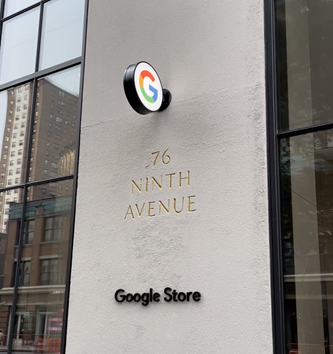‘I’m Feeling Lucky’: Google Bets on its First Physical Store to Bring the Brand Experience to Life
Steps away from Manhattan’s iconic Chelsea Market is Google’s flagship store; the first brick-and-mortar outpost for the company sits in a former Port Authority Terminal building. From in-store pickup to device troubleshooting and experiential vignettes, the store is a mecca to experience everything Google’s technology suite has to offer. However, for a name as ubiquitous as Google, many may wonder, what’s the point of expanding into brick-and-mortar? Google’s expansion was a strategic maneuver to provide customers with a physical pulse to associate with its smart-home products and technology and forge an identity among customers beyond its search engine persona.
The in-store experience encourages customers to explore and engage with the Google ecosystem
The store invites window shoppers inside through dynamic LED window displays that feature informational product content and advertisements on a rotating basis. Once inside, the main store interior echoes the floorplan of a home with toys and books playfully strewn around the center-store. The remainder of the sales floor and store perimeter allows customers to browse Google technology products, accessories, and limited-edition Google New York merchandise.

Photo Credit: McMillanDoolittle
The anchor to the store concept is Google’s ‘Experience Rooms’, which features immersive technology experiences highlighting specific Google products. The first room invites customers to get comfortable in Google’s mock living room as a part of the Nest Experience. As customers sit on the couch they’re guided through a series of prompts with Nest in the driver’s seat (with sound effects to boot), mimicking what Nest could look like in their own home.
Next, in a dark, cave-like room dotted with colored lights, is the Google Pixel walk-in photobooth. Here customers can take a test run of Google’s pixel camera as they’re guided through a series of staged photograph points.

Photo Credit: McMillanDoolittle
For gaming enthusiasts, Google boasts the Stadia gaming experience. The room hosts wall-to-wall demo installations of the gaming technology that allows you to play video games on screens you already own using their controller technology.
Calling upon one of Google Search’s mainstay features, is a Google Translate live demonstration. Using a triptych screen and a microphone, it translates a customer’s live speech into different languages and displays the text in real time. Google considered sanitation and customer safety in its store design, and entry into all of the experience rooms is completely contactless. Enabled by a simple wave of a palm in front of the door, this allows customers to traverse around the story worry-free.

Photo Credit: McMillanDoolittle
Google’s investment in customer relationships affords the tech giant a brand-building opportunity
Competing with the Apple Store service model, it is understandable that Google, too, wants to establish a physical footprint to showcase the brand, its technology and interact with customers through both sales and in-store service. Much like the legacy model of the Genius Bar, a help desk bearing a neon ‘Here to Help’ sign flanks the north end of the store. The pair shares similarities in their commitment to exceptional service as a pillar of the customer experience; however, the players differ in terms of store format and overall display: Apple stores champion sterility and sleek finishes, allowing the products alone to take center stage, predicated on the assumption that many customers are already familiar with their products.
Conversely, Google invested in the overall retail experience. Throughout the store the company demonstrates how Google’s technology products can be integrated into customers’ everyday activities. The store experience invites customers to linger and explore the different exhibitions, boasting product education by doing rather than reading or listening. These experiential vignettes create a sense of excitement and discovery among customers, cultivating a customer relationship beyond merely the transactional.
As a company itself, Google, a subsidiary of Alphabet Inc., is nothing short of a giant. With its parent company boasting a $1.9T market cap, the company dominates in search as well as on-line advertising, cloud computing, software, and other areas. However, Google also has more tangible solutions for the end consumer that can be showcased in a physical store. Google’s opportunity to focus on these solutions through a physical retail space is not only a means of connection and offering an exciting in-store experience, but also offers the company the opportunity to carve out a space where their home and mobile technology products take center stage.
This space also gives Google complete control over the brand experience. Mass retailers such as Bed Bath & Beyond and Best Buy already carry a myriad of Google’s technology products, however the company has minimal say in product standards, merchandising, staff training and the overall brand experience at these locations. Google’s entrance into brick-and-mortar offers the company complete ownership of the brand experience, an essential opportunity as they continue to capture share-of-mind as a major technology player.
Ultimately, building awareness and understanding of Google’s product offerings will expand the company’s positioning beyond just a search engine platform and solidify itself as a holistic technology, advertising, analytics, and retail company. To learn more about our work in retail strategy, concept development and digital transformation, contact us. To stay up to date on our latest retail insights, be sure to follow us on LinkedIn.

No Comments